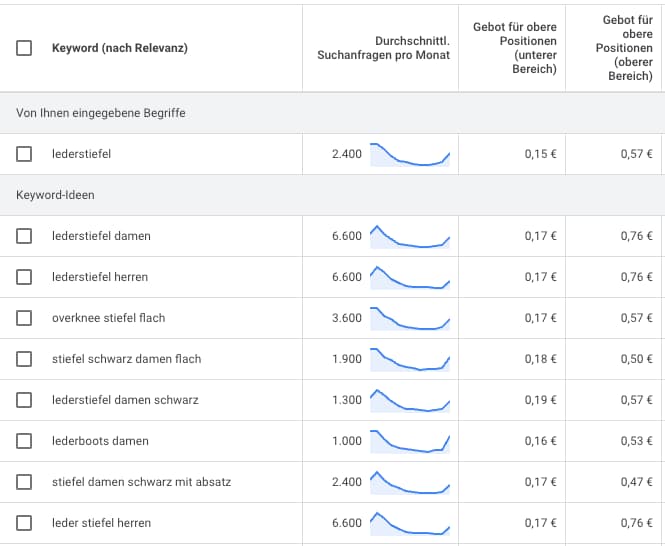The costs for Google Ads are quite easy to calculate, as billing is based on clicks. The click price fluctuates greatly, but in our experience it is between €0.50 and €4 for most campaigns. We have been able to run cheap campaigns at click prices of €0.03 - although cheap does not always equal successful. However, the Google Ads costs themselves are flexible and initial tests can be carried out even with small budgets.
These costs are incurred with Google Ads
The beauty of Google Ads: Only with one click costs are incurred by Google Ads when the user clicks on the ad. This is because behind the pricing for the CPC lies a Bidding process.
But also Other factors such as the quality score, ad rank or time of day can influence the CPC.
Nevertheless, in addition to the advertising budget, there are of course also indirect costs for the creation or optimization of campaigns.
We take it step by step.
Budget planning for Google Ads
As an agency, we encounter the following two customer scenarios in the 90% wilderness
- "We have an ads budget of €100,000"
- "What budget do you recommend?"

Case 1 is often historical. Annual plans are made where no one really knows where the amounts come from. It could have been blanket assumptions from the past such as "10% of turnover" or "3% of profit" for the marketing budget. Studies such as the B2B marketing budgets of the bvik. In this case, we as a Google Ads agency also work with what we are given and try to achieve the maximum in terms of the specified goals.
Case 2 ("What budget do you recommend?") is usually more difficult. This is because it is almost impossible to assess this from the outside; you need internal figures for this. For a valid calculation, we recommend a economic considerationwhich takes several factors into account.
Example (may vary depending on the business model):
- Conversion rateIf I have 100 visitors, how many visitors make conversions? For example, 3 out of 100 visitors place an order in my shop. Online store. Then my conversion rate is 3%.
- AOV - Average Order Value: What is the average order value across all my orders? Order 1 = 30 €, order 2 = 70 €, order. 3 = 50 €. (30+50+70) / 3 = 50 €.
- ProfitHow much profit am I left with per order? In other words, what is the maximum amount I can/want to spend on advertising for the order? If I have a profit of €30 on an order of €50, I don't want to spend more than €30 per order on advertising costs.
With these three core values, I can already make a simplified analysis for an initial calculation of my budget.
(Note: In practice, other factors such as CLV - Customer Lifetime Value - are included in the calculation later on. But we can leave that out for now).
Because with 100 visitors we now make 90 € profit (see above, 100 visitors = 3 orders á 30 € profit).
This means that I don't want to spend more than €0.90 on average for one click: 100 clicks * €0.90 = €90.
The big mistake in budget planning
A question we are often asked: "How high should my monthly budget for Google Ads be?"
The simple answer: As long as the search volume is high enough and the ROAS (Return On Ad Spend, see explanation below) is positive, I feed the advertising machine with money.
Why should I suddenly turn off the tap after spending €1,000 on ads if my campaigns are successful? Why shouldn't I invest another €1,000 if I can make another €3,000 in profit?
The ad budget is usually limited by demand (number of search queries) and profitability. (Or by my ability to deliver and my cash flow).
Sure: The above approach is quite simple. There are more complex cases where, for example, it is not about order values but about lead prices. But the core business approach always remains the same. What does a conversion (registration, purchase, contact details, etc.) bring me in € and how much do I want to/can I spend on advertising budget per conversion?
Only when this profitability no longer exists does it make sense not to invest any further budget.
Determine the click price (cost per click - CPC)
So now we know that we only have to pay money to Google when we click on an ad.
Although we only find out the exact price at the moment of the click, we can call up approximate click prices for search campaigns in advance.
The Keyword Planner Tool in the Google Ads account, where we can enter our keywords.

Here we can enter a keyword such as "leather boots".
The tool then gives us the average search queries per month and the approximate cost per click for the lower and upper ranges.
After all, it makes a difference whether my ad is in first place or at the bottom of the search results page on Google. The higher up I am positioned, the more expensive (as a rule) the click.
Average click prices (CPC) for Google Ads in Europe by country
In European countries, the following average click prices can be used as a guide about Orientation:
- Germany: 1,50 € - 2,50 €
- United Kingdom1,00 £ - 2,00 £ (approx. 1,15 € - 2,30 €)
- France: 1,00 € - 1,80 €
- Spain: 0,80 € - 1,50 €
- Italy: 0,80 € - 1,60 €
- Netherlands: 1,20 € - 2,00 €
- Belgium: 1,00 € - 1,80 €
- Switzerland2,00 CHF - 3,50 CHF (approx. 2,10 € - 3,70 €)
- Austria: 1,20 € - 2,00 €
- Poland: 0,30 € - 0,80 €
- Sweden: 1,00 € - 2,00 €
- Norway: 1,20 € - 2,50 €
- Denmark: 1,00 € - 2,00 €
- Finland: 0,90 € - 1,70 €
- Ireland: 1,00 € - 2,00 €
Trends:
- Countries with a higher cost of living and greater economic activity (e.g. Switzerland, Germany, the UK) generally have higher average click prices.
- Countries with less competition on the advertising market or lower advertising expenditure (e.g. Poland, Hungary) tend to have lower CPCs.
Note: These are not absolutely correct figures but have been compiled by us from several sources. The figures are based on general trends and reports that are common in the industry. For example, through tools such as Google Ads Keyword Planner, Statista, SEMrush and WordStream.
In practice, click prices vary greatly. Many factors such as seasonal fluctuations, industry-specific differences or even the quality of the ad and landing page have an influence on the click prices of campaigns.
We have run campaigns for clients where the average CPC was €0.03. In the pharmaceutical industry, click prices can quickly reach 10 - 12 euros.
In practice, however, it is not decisive how much I pay for a click.
The decisive factor is how high my return on ad spend (ROAS) is: if I spend an average of €10 per click and generate €100 in revenue, this is more lucrative than spending €0.02 per click and only generating €0.05 in revenue.
ROAS as an important metric

As already mentioned, it is important to know the ROAS.
ROAS (Return on Advertising Spend) measures how much revenue is generated per euro spent in advertising costs and thus shows the efficiency of an advertising campaign.
ROAS = Costs of the advertising campaign / Sales from advertising campaign
So if I have invested €100 in Google Ads and generated €200 in sales, my ROAS = 2.
As turnover is of course not the same as profit and other factors such as customer lifetime value (CLV) are also taken into account in marketing practice, ROAS is not the absolute truth, but it is an important metric.
Important: Inspect & Adapact - Measure & Adapt
We always make assumptions in our budget planning. These assumptions can be based on historical data. For example, I know from the past that I was able to achieve 3 sales with 100 visitors. So my conversion rate is 3 %.
In practice, it is now important to constantly review these assumptions.
This is because the quality of the traffic that comes via Google Ads can be different. This traffic may be stronger or weaker in terms of conversions. My conversion rate can therefore change.
The click price from the planning also often deviates slightly in reality.
It is therefore important to constantly monitor the assumptions from the planning with a marketing dashboard and take countermeasures if necessary.
This dashboard should transparently record all important key figures such as costs, turnover, number of clicks CPC or ROAS per campaign.
Consider additional expenses
In addition to the pure advertising budget for Google Ads, the additional expenses should also be taken into account.
This is because the conception and creation of the campaigns as well as the ongoing monitoring and adaptation naturally require resources. If this cannot be covered by internal staff, external support is required. Of course, as a Google Ads agency, we are happy to help.
The effort involved should not be underestimated.
There are of course initial tasks such as designing the campaign, Keyword research, defining the target group, creating ads, implementing conversion tracking or setting up reporting.
But ongoing support also requires constant attention. Campaigns need to be monitored and adjusted. This is the only way to ensure long-term SEA success with Google Ads.
Bidding strategy vs. AI
The bidding strategy used to be a big issue with Google Ads. This is because a permanent auction takes place. Who places which bid at which moment in order to be in which position? In the past, you had to determine the maximum CPC you wanted to spend. Today, this is still possible indirectly, but in essence, AI is now taking over auction management for us.
And that's a good thing: Because experience shows that AI always beats human bidding strategies. Therefore, the topic of bidding strategy is no longer an issue today.
Get external support
If you want to get serious about Google Ads, you should seek external support. Because despite all the AI support, running Google Ads profitably today requires more experience than ever before. This is because Google Ads is now highly saturated and without proper implementation, so much money is being wasted. At the end of the day, it's back to "Google Ads isn't worth it for us".
To avoid this, we offer a free strategy meeting with one of our senior consultants.



